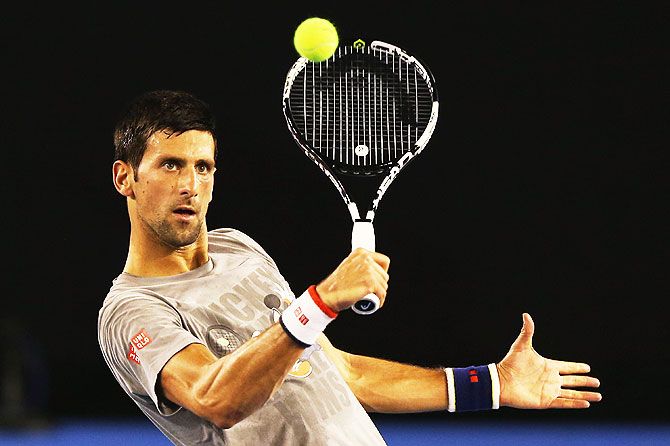 | « Back to article | Print this article |
Kinesiology, which can best be described as the science of movement, is complex yet holistic.
T E Narasimhan examines the art and the science of it.

For the past two years, R Dinesh, managing director of TVS Logistics, has been a committed enthusiast of Kinesiology.
It started with a friend suggesting that he try out Kinesiology to deal with a persistent and bothersome digestive problem. He put Dinesh in touch with Kinga Papp, a United Kingdom-based Kinesiology therapist.
"It improved the quality of my life tremendously. I am able to work better and take quick decisions," says Dinesh.
So much so, now many among his family, friends and colleagues have also turned to Kinesiology.
Abhishek Singh, a Delhi-based coach with Reebok CrossFit Robust and sports nutritionist, turned to Kinesiology for similar reasons.
He developed a shoulder pain that the several physiologists he consulted were unable to treat. So Singh, who had some idea about what Kinesiology was about, started researching the subject. He discovered that the problem lay with his rotator cuff, the sheath of tendons and ligaments that supports the arm at the shoulder joint.
In the simplest of terms, Kinesiology can be described as the science of movement. It is the study of the movements, performance and functions of the human (and animal) body.
Kinesiologists believe that if you are able to accurately understand the mechanics of the body's movement, you can also find out what is causing a particular problem in the body.
But Kinesiology isn't just aimed at identifying a problem and then helping treat it, say, through massages, acupuncture or exercise. It is also about improving the quality of life by improving the body's movement. And it is about helping athletes and sportspersons to purposefully work on the movement that they need to improve to perform better, says Singh.
Kinesiology, which is still trying to make inroads into India by targeting professionals, is popular in countries such as Australia, New Zealand, the UK and Hungary.
Several natural healing centres in these countries also have a Kinesiologist. However, but for Canada, where the world's first kinesiology department was launched in 1967, 'Kinesiologist' is not a licensed or professional designation.
Kinesiology basically uses muscle testing to "read" the body's feedback system.
When a specific muscle is tested with gentle pressure, a trained practitioner can detect the differences in its behaviour and can tell if the related body structure is under stress. This way a kinesiologist can tell where the health problem stems from, where the imbalances and energy drains are, and what particular stresses are affecting the person, says Papp.
Kinesiology is complex to explain in words, but Singh tries.
"Say, you have pain in the left shoulder," he says. A kinesiologist may ask you to touch your right shoulder with your left hand and then gradually raise your left elbow. If you are unable to raise your elbow to a level above your left shoulder while still touching your right shoulder with the left hand, there is a strong possibility that you have a problem with your rotator cuff.
A simple movement such as this can help identify the trouble spot that needs to be then treated.
Or you might be asked to hold your arms to your sides, by your body, and then gradually raise them ahead of you. If you are unable to cross the 90-degree angle, and experience pain, then too it might be a rotator cuff issue.
"So, there are several movements or muscle tests in Kinesiology that can point to a specific problem," says Singh.
Like Singh, Papp too turned to Kinesiology because she felt it healed her.
Papp, who worked in the highly demanding world of advertising, would often fall ill due to work pressure and stress. She had no work-life balance. After going through several treatments, she went to a Kinesiologist. She says she walked in a patient and walked out full of energy.
A body's movement, says Singh, impacts everything: its physical, psychological, emotional and nutritional aspect. Conversely, a person's physical, psychological and emotional state and diet have a bearing on the body's movement. A holistic therapy, Kinesiology tries to cover all of this.
Tennis player Novak Djokovic, for instance, was diagnosed with gluten intolerance using applied kinesiology.
"We try to correct these imbalances using lymphatic massage, nutrition, electrical balancing and emotional therapy," says Papp.
Gentle stimulation on acupressure points, nutritional changes, lifestyle changes, brain re-patterning, emotional clearing, vibrational or flower essences (use of plants and other substances to assist the body's healing process) are some of the healing techniques that are also used.
Kinesiology was developed in the 1960s by George Goodheart, who was the first official US Olympic team chiropractor. He combined modern Western techniques and knowledge drawn from Eastern, mainly Chinese, health systems to come up with this form of therapy.
For sportspersons especially, Kinesiology proves quite effective.
"For example, there is the gait analysis, which is helpful if a person is training for, say, a marathon," says Singh who believes that the terms "exercise scientists" and "kinesiologists" can be used interchangeably. How you run, the way you swing your arms, the position of your head, shoulders and upper torso during the run, and the way you land your feet -- all of these will define your performance at the marathon.
Kinesiologists are of the opinion that everybody, including animals, follows Kinesiology, even if unknowingly. A sound understanding of the movements can help a person achieve a lot more from the body.
"If you know the right movements for the particular body muscle, you will be able to make the most of that one hour you spend in the gym," says Singh. That's Kinesiology.